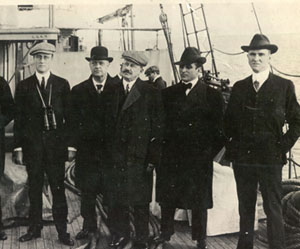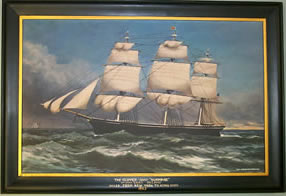
|
FDR and the Navy It is especially fitting that a United States Navy ship bear the name "Franklin Roosevelt" because few American presidents have revered the Navy as much as Franklin Roosevelt. President Roosevelt's love affair with the sea began at an early age; one could say it started before he was born. His mother's family - the Delanos - were seafaring people. They were merchants and mariners; Sara Delano Roosevelt's father owned one of the most famous clipper ships of its time. The Roosevelt home was nestled in the Hudson River Valley, overlooking the river. Franklin spent the days of his youth boating on the Hudson in his ship the Half Moon and an ice boat and when the family summered in Campobello, New Brunswick, Canada, FDR perfected his sailing skills.
Franklin Roosevelt's love of the water naturally transferred itself into a love of the Navy, forging a special relationship. Following in the footsteps of his cousin Theodore Roosevelt (another Roosevelt who loved the Navy and even wrote a naval history of the War of 1812), FDR served as Assistant Secretary of the Navy from 1913-1920 during Woodrow Wilson's presidency. He was responsible for procurement and shipping supplies to the front. It was a mangement role and FDR loved it because "I get my fingers into everything." Roosevelt loved his position in the Navy. He was comfortable with Navy men for they shared a common language, an ease and familiarity that his superior Secretary of the Navy Josephus Daniels did not have, but FDR often wished to take a more commanding role. He and Daniels differed in their views of the Navy. FDR wanted a bigger navy and thought that the North Carolinian intellectual Daniels was "too damned slow," but the two men respected each other (as president, FDR later appoints Daniels as Ambassador to Mexico to secure the Good Neighbor Policy). FDR was in the Navy Department during World War I and learned valuable lessons on how to manage the Navy during war. He pushed Daniels for a commission during the war but was turned down because his job in Washington was too important. In fact, one of FDR's biggest accomplishments during WWI was convincing the British to mine the North Sea which effectively slowed German U-boats. He was sent to Europe to inspect bases and negotiate naval contracts and surplus material.
FDR's respect
for the Navy continued throughout his life. During his tenure as Assistant
Secretary of the Navy, FDR collected naval prints and ship models. At the
time of his death, his collection was quite large and covered the long
history of the navy. He had prints about all the wars and important naval
figures such as Commodore Mathew Perry and John Paul Johns as well as from
famous artists such as Currier and Ives. In fact, one of the prints in his
collection is thought to be the earliest image of John Paul Jones ever
printed. The collection also includes 2 log books from the USS
Constitution
("Old Ironsides") dating back to 1815 and documents from
former Secretaries of the Navy.
|
 (Photo: FDR (left) on board the USS
Dolphin
as Assistant Secretary of the Navy, 1913.)
(Photo: FDR (left) on board the USS
Dolphin
as Assistant Secretary of the Navy, 1913.)
 (Photo: A
print of the ship SURPRISE from FDR's collection.)
(Photo: A
print of the ship SURPRISE from FDR's collection.)